|
Cassowaries |
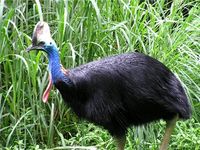
Southern Cassowary
|
|
Scientific classification |
| Kingdom: |
Animalia
|
| Phylum: |
Chordata
|
| Class: |
Aves
|
| Order: |
Struthioniformes
|
| Family: |
Casuariidae
|
| Genus: |
Casuarius
Brisson, 1760 |
|
| Species |
Casuarius casuarius
Casuarius unappendiculatus
Casuarius bennetti |
Cassowaries (genus
Casuarius) are very large
flightless
birds native to the tropical forests of New Guinea and
northeastern Australia. Some nearby islands also have small
cassowary populations, but it is not known if these are
natural or the result of the New Guinea trade in young
birds. They are frugivorous; fallen fruit and fruit on low
branches is the mainstay of their diet. They also eat fungi,
snails, insects, frogs, snakes and other small animals. Recently, they have also
been observed to attack humans, though this usually only
occurs in self-defense when humans intrude upon the birds'
territory or cause them to feel threatened.
Cassowaries (from the
Indonesian name kasuari) are part of the
ratite group, which also includes the
emu,
rhea,
ostrich,
moa,
and
kiwi. There are three species recognized today:
-
Southern Cassowary or double-wattled
cassowary C. casuarius of
Australia and New Guinea.
-
Dwarf Cassowary C. bennetti of New Guinea
and
New Britain.
-
Northern Cassowary C. unappendiculatus of
New Guinea.
The Northern and Dwarf Cassowaries are not well known.
All cassowaries are usually shy, secretive birds of the deep
forest, adept at disappearing long before a human knows they
are there. Even the more accessible Southern Cassowary of
the far north
Queensland rain forests is not well understood.
The evolutionary history of cassowaries, as all ratites,
is not well known. A fossil species was reported from
Australia, but for reasons of
biogeography this assignment is not certain and it might
belong to the prehistoric "emuwaries", Emuarius,
which were cassowary-like primitive emus.
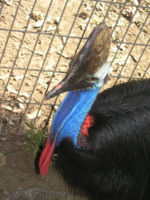
Detail of Cassowary head
The Southern Cassowary is the second-largest bird in
Australia and the third-largest remaining bird in the world
(after the ostrich and emu). Adult Southern Cassowaries are
1.5 to 1.8 m (5 to 6 feet) tall, although some may reach 2m
(6 feet 8 inches), and weigh about 60 kilograms (130
pounds). They have a bony casque on the head that is used to batter through
underbrush, making them the only armoured bird in the world.
Females are bigger and more brightly coloured.
A cassowary's three-toed feet have sharp claws; the
dagger-like middle claw is 120 mm (5 inches) long. This claw
is particularly dangerous since the Cassowary can use it to
kill an enemy, disemboweling it with a single kick. They can
run up to 50 km/h (32 mph) through the dense forest, pushing aside
small trees and brush with their bony casques. They can jump
up to 1.5 m (5 feet) and they are good swimmers.
The 2004 edition of the Guinness World Records lists the
cassowary as the world's most dangerous bird. Normally
cassowaries are very shy but when disturbed can lash out
dangerously with their powerful legs. During World War II
American and Australian troops stationed in New Guinea were
warned to steer clear of the birds. They are capable of
inflicting fatal injuries to an adult human. Usually,
attacks are the result of provocation. Wounded or cornered
birds are particularly dangerous. Cassowaries, deftly using
their surroundings to conceal their movements, have been
known to out-flank organized groups of human predators.
Cassowaries are considered to be one of the most dangerous
animals to keep in zoos, based on the frequency and severity
of injuries incurred by zookeepers.
More recently, Cassowaries have been known to lose their
natural fear of people. As a result, large areas of
Australian National Parks have been temporarily closed to
avoid human contact with the bird.
Females lay three to eight large, pale green-blue
eggs in each clutch. These eggs measure about 9 by 14 cm
(3˝ by 5˝ inches) — only
ostrich and
emu
eggs are larger. The female does not care for the eggs or
the
chicks; the male
incubates the eggs for two months, then cares for the
brown-striped chicks for nine months.
Southern and Northern Cassowaries are threatened species
because of habitat loss; estimates of their current
population range from 1500 to 10,000 individuals. About 40
are kept in captivity in Australia. Habitat loss has caused
some cassowaries to venture out of the rainforest into human
communities. This has caused conflict particularly with
fruit growers. However, in some locations such as Mission
Beach, Queensland, tourism involving the birds has been launched.
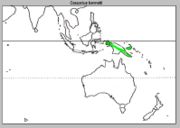
Distribution of Casuarius bennetti
|
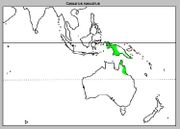
Distribution of Casuarius casuarius
|
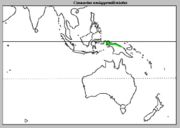
Distribution of Casuarius
unappendiculatus
|
References
- Stay in Touch, Philip Clark (ed),
The Sydney Morning Herald, 5 November 1990.
Cites "authorities" for the death claim.
- Underhill D (1993) Australia's Dangerous
Creatures, Reader's Digest, Sydney, New South Wales,
ISBN 0-86438-018-6
- Readers' Digest, June 2006 issue.
External links




